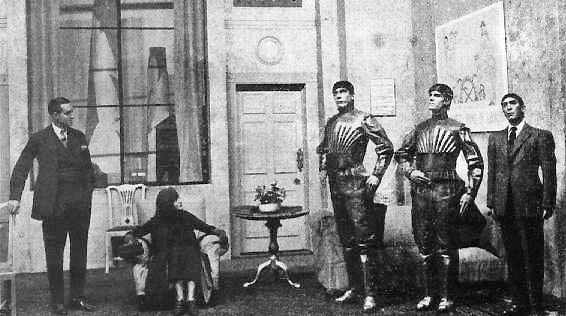Museum hopes to rebuild UK's first robot
In today's fantastic age of automation and advanced robotics, with creations like Honda's ASIMO, human-looking androids and unmanned drones posing the question of where this technological development may ultimately lead us, it is easy to forget that the beginnings of modern robotics date back almost a century. Indeed the very term "robot" was only coined in 1921, when it appeared in the Czech play R.U.R (Rossum's Universal Robots) - an early piece of science-fiction that like so many since depicted a future mechanical uprising by intelligent machines.
 | |
| source A scene from the 1921 Czech play R.U.R., written by brothers Josef & Karel Čapek |
Within a decade (perhaps, as some social commentators have suggested, as a response to the remarkable level of mechanization seen in the First World War) robots had evolved in all-metal humanoids, the most famous in fiction being the Maschinenmensch "Maria" in Fritz Lang's 1927 sci-fi epic Metropolis.
 |
| source |
It's fascinating to read of the response of the crowd to this unexpected guest speaker, as described by Popular Science Monthly, and how in so many ways it still chimes with our own hopes and fears about the future of technology nearly 100 years later:
"The Thing's enormous size and the stark immobility of his face gave him a really terrifying quality... [the crowd] returned his lifeless gaze. They felt subconsciously that here was some strange symbol of relentless Fate itself."
Personally I like the idea of a machine that would "Rid the World of Drudgery" and, despite the rather frosty initial reception, it seems that audiences of the time agreed as Eric went on tour to technology fairs around the world throughout the rest of the 1920s and early 1930s.
However Eric's ultimate fate remains a complete mystery; no trace of him exists after about 1932. Whether he was dismantled, destroyed or is still sitting in someone's shed somewhere waiting to be rediscovered we may never know, but now comes the exciting news that the London Science Museum intends to build a full-size replica of the original Eric to become one of the main attractions of its 2017 Robots Exhibition.
It sounds an intriguing project, all told, and I feel sure that the Science Museum will be able to raise the funds to build the new Eric. I look forward to reading more about his reconstruction and seeing this important early milestone in the history of robotics in London in 2017 - just as long as he doesn't go mad and try to overthrow humanity!
**The Science Museum's Kickstarter campaign "Rebuild Eric: The UK's First Robot" can be found here**





Splendid, what a fantastic creation. I wonder what happened to the fellow.
ReplyDelete